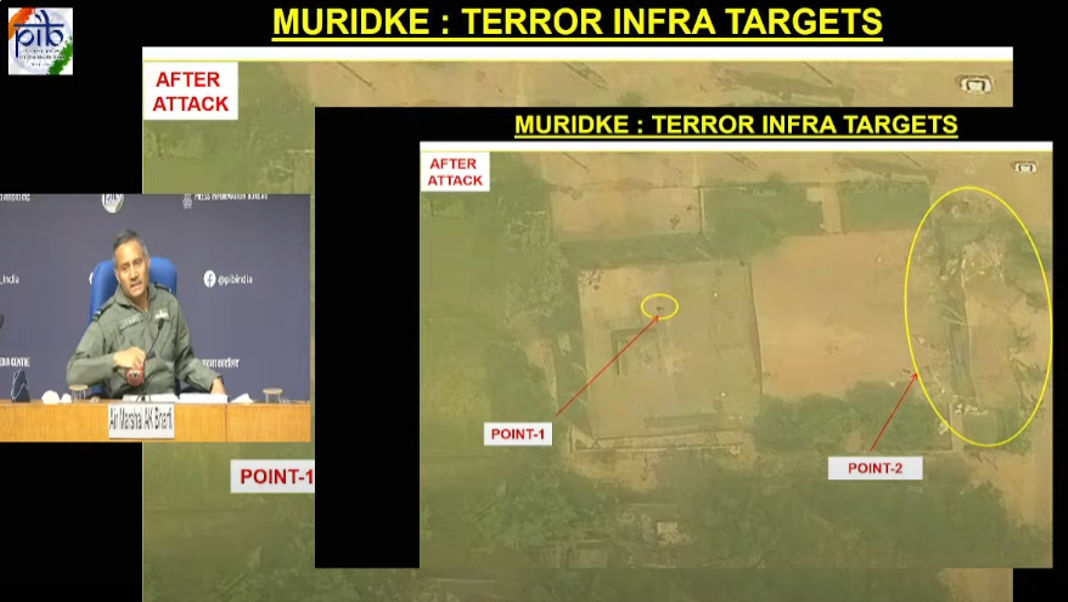Guwahati , May 11: Top commanders from the Army, Air Force, and Navy revealed the scale and precision of Operation Sindoor, India’s retaliatory military campaign launched in response to the brutal Pahalgam massacre that claimed 26 civilian lives on April 22.
“We struck where it would hurt,” said Air Marshal A.K. Bharti, underscoring the intensity of the operations. “We have the capability to target every system at these bases—and more.”
At the briefing, a detailed missile impact video of the Muridke terror camp was released, offering a glimpse into the Indian Armed Forces’ highly targeted strikes on terrorist infrastructure. The Director General of Military Operations (DGMO), Lt. Gen. Rajiv Ghai stated, “Operation Sindoor was conceived with a clear military objective: to punish the perpetrators and destroy the terror infrastructure that enables them.” India lost 5 soldiers in Operation Sindoor, DGMO Lieutenant General Rajiv Ghai confirmed. “Their sacrifices shall always be remembered and honoured by a grateful nation,” Ghai said. All the pilots of the Indian Air Force have returned home safely, Ghai added.
Air Marshal Bharti detailed a barrage of attacks from Pakistani unmanned aerial vehicles (UAVs) and drones that began on the evening of May 7. “They came in waves, targeting civilian and military assets. Our robust counter-UAV systems—both hard-kill and soft-kill—neutralized nearly all threats. A few drones managed to land but caused only minor damage,” he said.

On May 8, around 2000 hours, a second wave of attacks was launched by Pakistan using drones and combat aerial vehicles, attempting simultaneous strikes on multiple Indian Air Force bases. “Our crews were fully prepared,” Bharti said. “Using both modern and legacy air defense systems—including the Pechora missiles—we ensured there was zero damage on the ground.”
In response, India launched a swift, coordinated, and calibrated strike on key Pakistani military targets across the western front. “We hit air bases, command centers, military infrastructure, and air defense systems,” Bharti stated. “Targets included Chaklala, Rafiqui, Rahim Yar Khan, Sargodha, Bhulari, and Jacobabad. Chaklala, notably located in Islamabad, was struck to deliver a clear message—aggression will not be tolerated.”
When asked about casualties, Bharti said: “Our goal was not body counts. Whatever means we used had the desired effect on enemy targets. If there were casualties, it’s for them to count. Our job is to hit the target, not to count the body bags.”


From the maritime front, Vice Admiral A.N. Pramod said the Indian Navy’s response was immediate and resolute. “Following the cowardly attack in Pahalgam, our carrier battle groups, submarines, surface vessels, and aviation assets were deployed with full combat readiness,” he said.
Within 96 hours of the April 22 attack, the Navy conducted multiple weapons tests and maneuvers in the Arabian Sea. “Our forces remained forward-deployed in the northern Arabian Sea, in a decisive and deterrent posture,” Pramod noted. “We were prepared to strike selective targets on land and at sea—including Karachi—at a time of our choosing.”
Pramod emphasized that India’s naval posture has forced Pakistan’s navy and air force into a defensive crouch, remaining mostly in harbors or hugging the coastline. “Our response has been measured, proportionate, and non-escalatory. As we speak, the Indian Navy remains at sea, ready to respond decisively to any hostile action.”
Also Read: India condemns Pakistan’s escalation; civilian areas and religious sites targeted in drone strikes
Watch
Find latest news from every corner of Northeast India at hubnetwork.in, your online source for breaking news, video coverage.
Also, Follow us on-
Twitter-twitter.com/nemediahub
Youtube channel- www.youtube.com/@NortheastMediaHub2020
Instagram- www.instagram.com/ne_media_hub
Download our app from playstore – Northeast Media Hub





